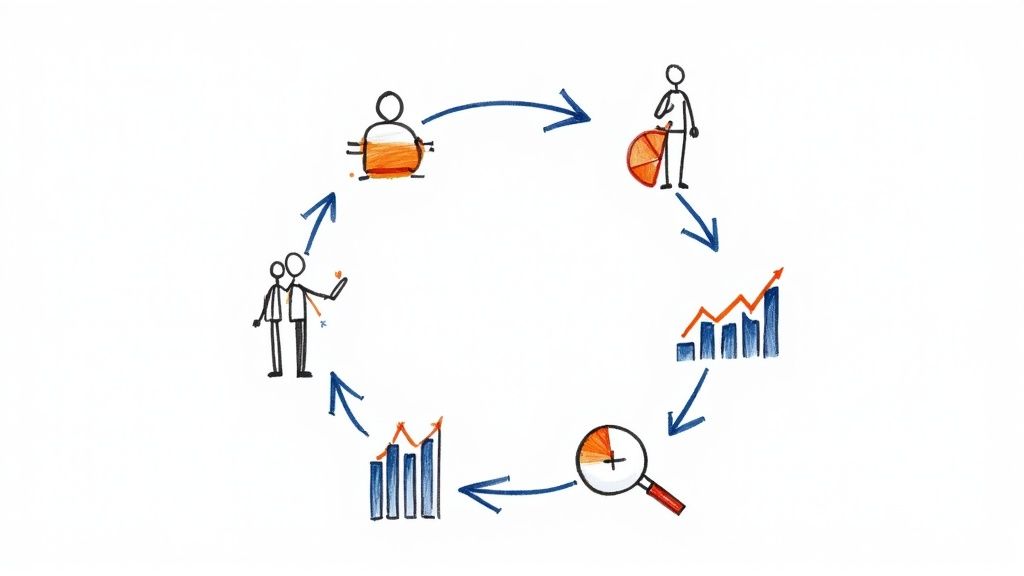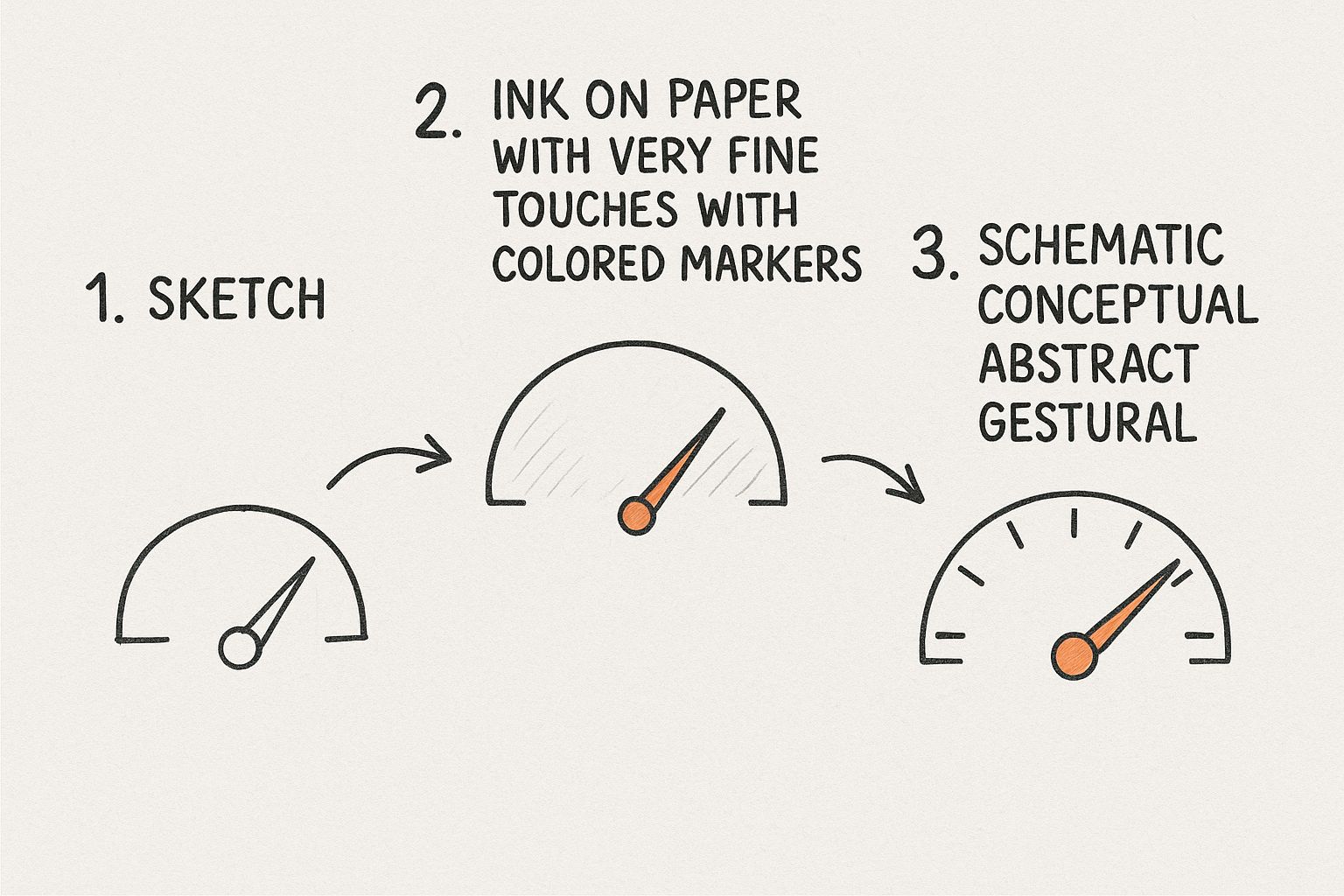
How Do You Measure Customer Engagement? Key Strategies
When you hear "customer engagement," what comes to mind? Too often, people get hung up on surface-level stats like page views or social media likes. But real engagement goes so much deeper than that.
We're talking about the meaningful interactions a customer has with your brand over time. It’s about tracking a whole set of behaviors—things like how often they use your product, how long they stick around in a session, and whether they give you feedback. These actions are what truly signal a customer's investment and help predict their future value to your business.
What Is Customer Engagement and Why It Matters
True customer engagement is a measure of the strength and quality of the relationship you have with a customer. It's the stark difference between someone who logs in once and ghosts you versus someone who becomes a power user of key features, offers feedback, and even tells their friends about you.
Shifting your focus from those "vanity metrics" to these deep behavioral patterns is absolutely critical for sustainable growth. When you understand engagement, you can finally pinpoint who your most loyal customers are, spot those who might be about to churn, and discover golden opportunities to make your product and overall experience better. It transforms engagement from a fuzzy concept into a powerful, proactive business tool.
The Three Pillars of Engagement
To really get a handle on it, I find it helpful to break engagement down into three core categories. Each one gives you a different, but equally important, perspective on your customer relationships.
- Behavioral Engagement: This is all about what customers do. Think about actions like logging into your app, using a specific feature, or clicking through your latest email. It's the most tangible part of engagement.
- Emotional Engagement: This covers how customers feel. Are they happy? Loyal? Frustrated? You can measure this through things like Net Promoter Score (NPS) or Customer Satisfaction (CSAT) surveys. It’s the heart of the relationship.
- Cognitive Engagement: This is about what customers think and the mental energy they invest in you. Are they carefully reading your blog posts? Are they actively participating in your webinars? This shows they’re intellectually invested.
Looking at engagement through these three lenses helps you connect the "why" with the "what."
By analyzing these combined signals, you stop guessing and start making decisions backed by real data. This is so important because truly engaged customers aren't just buyers—they become your biggest advocates, driving organic growth and providing feedback you just can't buy.
The chart below really highlights the massive financial commitment companies are pouring into this area.
That data tells a clear story: the global market for engagement tools is on track to more than double by 2030. This isn't just a trend; it's a fundamental shift in business. Mastering how to measure and improve customer engagement is no longer a "nice-to-have." It’s a necessity. The intense demand for personalized experiences is fueling huge investments in the strategies and technologies that make it all possible.
To help you get started, we can group the most common metrics into a few key categories.
Core Customer Engagement Metric Categories
Here's a quick look at the main types of metrics you'll want to track, what they measure, and some concrete examples to get you thinking.
This table isn't exhaustive, of course, but it provides a solid framework. By tracking a mix of these metrics, you can build a holistic and much more accurate picture of how engaged your customers truly are.
Tracking Actions That Signal True Engagement
Let’s be honest: surface-level likes and page views don’t tell the whole story. To really understand how to measure customer engagement, you have to look at what people do. The real insights are found in their actions—the behavioral metrics that show genuine interest and investment in what you offer.
True engagement isn't passive. It's not about counting website visitors; it's about digging into how long they stick around and what they click on during their visit. Spotting these patterns is how you separate the casual browsers from the people who are truly on the hook.
Focus on Active User Behavior
One of the most revealing metrics for product health is the DAU/MAU ratio (Daily Active Users divided by Monthly Active Users). It’s a simple calculation that tells you how "sticky" your product is—what slice of your monthly users comes back every single day.
A high DAU/MAU ratio is a fantastic sign that your product has become a habit. For a B2B SaaS tool, a healthy ratio might hover around 15-20%. For something like a social media app, you’d want to see that number climb to 50% or higher.
Another metric I always keep an eye on is session duration. Are people actually spending quality time with your content, or are they bouncing away after a few seconds? Longer sessions on your key pages usually point to higher interest and a much better user experience. A great way to boost this is by trying out new formats; for example, you can learn more about using interactive video to drive SaaS customer engagement and collect valuable data at the same time.
Track Key Conversions and Feature Adoption
Remember, not every valuable action is a sale. Some of the best indicators of a budding relationship are non-monetary conversions.
Think about actions like:
- Signing up for your newsletter
- Registering for a webinar
- Downloading a whitepaper or case study
- Finishing an onboarding checklist
Each of these shows a user is willing to give you their time and attention. They're clear signals that you're delivering value that goes beyond a simple transaction.
Key Takeaway: The most engaged customers are often the ones who adopt your core features quickly and use them all the time. Tracking your feature adoption rate helps you pinpoint your power users and see which parts of your product are really hitting the mark.
This infographic is a great way to visualize how these different behavioral metrics stack up to create an overall picture of engagement.

When you see metrics like session time, feature adoption, and activity rates all trending up, you know the overall health of your customer base is strong. Of course, this applies to every channel you use to connect with customers. To get a complete picture, it’s crucial to understand the essential social media performance metrics that give you real insight into public engagement. By reading these trends correctly, you can spot your most loyal fans and—just as importantly—identify anyone who might be drifting away before it’s too late.
Measuring How Your Customers Truly Feel

Behavioral data is great for telling you what your customers are doing, but it almost always misses the most important part: why they're doing it. Clicks, session times, and feature usage are just numbers on a screen. They don't tell the whole story.
To really get a grip on customer engagement, you have to look beyond the actions and start figuring out how your customers actually feel. This is where the human element comes in. We’re talking about sentiment, loyalty, and how people perceive your brand.
Think about it. A customer who uses your product every single day but is secretly frustrated is a huge churn risk waiting to happen. That frustration is the kind of insight you won't get from a usage dashboard.
Turning Scores into Stories
The most straightforward way to find out how someone feels? Just ask them. A couple of battle-tested tools for this are the Net Promoter Score (NPS) and Customer Satisfaction (CSAT) surveys. They give you a quick, clean snapshot of customer sentiment at key moments.
- Net Promoter Score (NPS): This one cuts right to the chase with the ultimate loyalty question: "On a scale of 0-10, how likely are you to recommend our brand to a friend or colleague?" This buckets your customers into Promoters (9-10), Passives (7-8), and Detractors (0-6), giving you a clear picture of who your biggest fans are (and who aren't).
- Customer Satisfaction (CSAT): Usually sent right after a specific interaction, like a support call or a new purchase. A CSAT survey asks customers to rate their satisfaction on the spot, giving you immediate, focused feedback on critical parts of your customer journey.
Expert Tip: Don't just obsess over the score. The real gold is in the open-ended follow-up question, like, "What's the main reason for your score?" This is where you get the unvarnished truth, in your customers' own words, about what's working and what’s driving them crazy.
This is the kind of feedback you can actually do something with. A sudden dip in your average NPS, for instance, can be a major red flag for a widespread problem, even if your usage metrics look perfectly healthy. I've seen it happen: a software company had high daily usage, but their NPS was tanking. Turns out, a recent update—while technically functional—had made a key workflow a nightmare for their power users.
Reading Between the Lines
Your customers are talking about you all the time, even when you're not asking for their opinion. The trick is knowing where to listen. Social media, product review sites, and support ticket conversations are absolute treasure troves of honest, unfiltered feedback.
Digging into this unstructured data helps you connect the dots and find the "why" behind the numbers. You might be tracking social media mentions and notice a sudden spike in frustrated comments about a new feature. This is your cue to investigate.
Beyond just monitoring, using AI customer support solutions can do more than just speed up response times. They can analyze conversations in real-time to give you a constant pulse on how customers feel. When you combine direct feedback from surveys with this unsolicited chatter, you get a complete, 360-degree view, turning vague feelings into something you can actually measure and improve.
Using Tech and AI for Smarter Measurement
Let's be honest: trying to track every single customer interaction by hand is a recipe for disaster. It's not just difficult; it's pretty much impossible once you have more than a handful of customers.
This is where technology becomes your best friend. The real answer to "how do you measure customer engagement?" today lies in smart platforms. Tools like Customer Relationship Management (CRM) systems and Customer Data Platforms (CDPs) are your central command center for all things customer-related.
They work by pulling in data from every place your customers interact with you—website visits, email opens, support tickets, social media comments—and stitching it all together into one clean, unified profile. This gives you a complete story for each customer, letting you finally ditch those disconnected spreadsheets.
Let AI Do the Heavy Lifting
Now, let's talk about the real game-changer: Artificial Intelligence. AI and machine learning are completely flipping the script on engagement measurement. Instead of just looking in the rearview mirror at what already happened, AI helps you predict what’s coming next.
AI can sift through mountains of data and spot subtle patterns a human analyst would almost certainly miss. It can pinpoint which customers are your biggest fans and, more importantly, which ones are quietly showing signs they might be about to leave.
This predictive power is everything. If you really want to dig into user behavior, especially from your website traffic, Mastering organic search in Google Analytics is a great place to start. These platforms let you analyze the digital body language of your audience with incredible accuracy.
The results speak for themselves. The Braze Global Customer Engagement Review found that a massive 79% of organizations using AI have managed to automate routine tasks. This frees up your team to think strategically instead of getting buried in manual data entry. What's more, AI-driven personalization has been shown to boost conversion rates by up to 15%, proving its direct impact on both engagement and the bottom line.
Key Insight: The true magic of AI in engagement isn't just about doing things faster; it's about being smarter. An AI model can look at thousands of data points—login frequency, feature usage, support ticket sentiment—and create a predictive engagement score. This flags at-risk customers before they've already decided to churn.
Building a Proactive, Data-Driven Strategy
When you properly integrate this tech, your entire approach shifts from reactive to proactive. You stop asking, "What happened?" and start asking, "What's likely to happen next?" This allows you to step in with timely, personalized actions that make your customers feel seen and understood.
Think about these real-world scenarios:
- An AI system flags a high-value customer whose use of a key feature has suddenly dropped. This automatically triggers an alert for their customer success manager to check in.
- Your marketing platform uses engagement data to send a personalized discount to a user who has viewed a product page three times but still hasn't bought it.
- An L&D platform sees that a group of learners is struggling with a specific module based on their interaction patterns. It then automatically offers them extra resources to help them succeed. This ties directly into the core principles of evaluating learning, which you can read more about in our guide on how to measure training effectiveness.
The data backs this up. This chart from Contentsquare clearly shows what brands are focused on.
"Understanding the full customer journey" and "understanding customer behavior" are the top two priorities by a long shot. This underscores just how critical it is to have integrated tech that can connect the dots and give you that complete picture of engagement—which is exactly what modern, AI-powered tools are built to do.
Adapting Your Strategy for Global Markets

So, you ask, "how do you measure customer engagement?" The truth is, the answer changes depending on where you're standing on the map. A strategy that crushes it in New York might completely flop in Tokyo or São Paulo.
Why? Because cultural norms, communication styles, and even which tech people use day-to-day will drastically change how they interact with you. If you ignore these differences, you're setting yourself up to misread your own data.
For instance, directly asking for feedback is pretty standard in North America. But in some Asian cultures, that same request can feel a bit intrusive. A low survey response rate there might not signal disinterest at all—it could just be a cultural preference for a softer touch. This is exactly why a one-size-fits-all approach to measurement will give you a skewed picture of reality.
Standardize the Core, Differentiate the Details
The trick is to find that sweet spot between global consistency and local flavor. You need a core set of metrics that are standardized across every market to make real comparisons, but you also need the freedom to tweak how you collect and interpret that data on the ground.
First, lock in your universal engagement indicators. These are the big-picture numbers tied directly to your business goals. They shouldn't change, no matter the country.
- Customer Retention Rate: The ultimate thumbs-up. It shows you're delivering value, period.
- Product Adoption Rate: This tells you how quickly new users are getting to grips with your most important features.
- Customer Lifetime Value (CLV): A standardized financial metric that’s your North Star for long-term business health.
Once you have this foundation, you can get creative with your regional approach to qualitative and behavioral feedback.
Key Insight: The goal isn't to invent a whole new set of metrics for every country. It's about keeping the 'what' consistent (e.g., measuring satisfaction) while being flexible on the 'how' (e.g., using different survey methods or communication channels).
This approach lets you compare apples to apples, without disrespecting the unique cultural context of each market.
Contrasting Market Maturity
The local tech scene also plays a massive role. In mature markets, your customers probably expect a flawless, integrated experience across their laptop, phone, and tablet. But in high-growth regions, many people might be leapfrogging older tech entirely.
Right now, North America and Western Europe are leading the customer engagement hub market because digital transformation has been a priority for years. In stark contrast, the Asia-Pacific region is set to see the highest growth by 2028, fueled by the adoption of IoT-based sensors and AI-driven analytics for creating hyper-customized services. You can dig deeper into these trends in the full customer engagement hub market report.
What does this mean for you? Your strategy for a market like Germany might be all about perfecting a slick desktop and mobile web experience. But for a market like India, you’ll likely need a mobile-first—or even mobile-only—strategy, maybe even using channels like WhatsApp for support and feedback. By tailoring your approach like this, you get a much truer, more nuanced view of your global customer engagement.
Common Questions About Measuring Engagement
Even with a solid grasp of the metrics, putting theory into practice always brings up a few more questions. These are some of the most practical queries we see from teams when they start to seriously measure customer engagement. The goal here is to give you clear, actionable answers based on real-world experience.
How Often Should I Measure Customer Engagement?
The honest answer? It completely depends on the metric. Think of it like checking your car's vitals—some things you glance at daily, others only need a look every few months.
For high-velocity behavioral metrics like Daily Active Users (DAU) or session duration, you should be looking at them daily or weekly. This rhythm is crucial for fast-moving digital products, helping you catch immediate trends and react quickly to changes in user behavior.
But for more strategic, long-term indicators like Net Promoter Score (NPS) or Customer Lifetime Value (CLV), a quarterly or semi-annual review makes much more sense. This cadence gives you enough time to see meaningful patterns emerge, so you don't overreact to small, temporary blips.
What Is the Single Most Important Engagement Metric?
This is the million-dollar question, but there’s no single magic metric that rules them all. The "most important" one is always tied directly to your specific business model and what you're trying to achieve.
If I absolutely had to pick one, I’d lean toward the customer retention rate (or its inverse, churn rate). Retention is the ultimate proof that your engagement strategy is connecting with customers. If they consistently choose to stick around, it’s a powerful sign you're delivering sustained value.
A high retention rate is the result of successful engagement, not the cause. To get a complete picture, I always recommend pairing retention data with product adoption rates and a key sentiment metric like NPS. This gives you both the "what" and the "why."
Can I Measure Engagement Without Expensive Tools?
Absolutely. You don't need a massive budget to start gathering valuable insights. Plenty of free or low-cost tools can give you a fantastic start on your journey to understanding customer engagement.
Here’s a simple, effective starter kit that won't break the bank:
- Google Analytics: It’s a powerhouse for tracking essential website behaviors like session duration, pages per visit, and goal completions (like a newsletter signup).
- Google Forms or SurveySparrow: You can easily run simple CSAT or NPS surveys to gather direct customer feedback without spending a dime.
- Social Media Analytics: Every major platform—from Facebook to LinkedIn—provides built-in analytics to track comments, shares, reach, and other key social signals.
The secret isn’t having the fanciest tools; it’s about picking a few meaningful metrics and tracking them with relentless consistency.
How Do I Create a Single Customer Engagement Score?
Creating a composite or blended engagement score is an excellent way to get a quick health check on individual customers. It’s all about combining and weighting your most important metrics into one number.
First, pick three to five of your most critical indicators. For a SaaS company, this might be login frequency, key feature usage, and NPS. Then, assign a weight to each metric based on its importance to your business goals. For example, you might decide that using a core feature is twice as important as just logging in.
Finally, you normalize the data for each user (so all metrics are on a comparable scale, like 1-100) and combine them into a single, unified score. This gives you an at-a-glance view of who your most—and least—engaged customers are, so you know where to focus your efforts.
Transform your passive video content into an engagement powerhouse. With Mindstamp, you can embed questions, buttons, and personalized paths directly into your videos to capture leads, measure comprehension, and drive action. See how it works.
Get Started Now
Mindstamp is easy to use, incredibly capable, and supported by an amazing team. Join us!



Try Mindstamp Free










